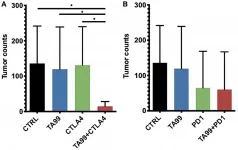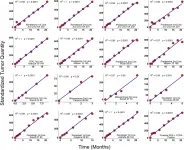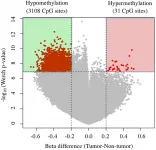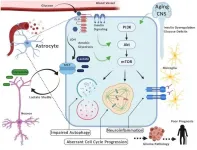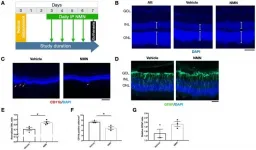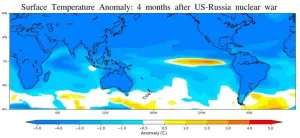Male breast cancer patients face high prevalence of heart disease risk factors
Findings indicate greater need for involvement of cardiologists, cardio-oncologists in this rarer patient population
2021-01-25
(Press-News.org) Male breast cancer patients were found to have a high prevalence of cardiovascular conditions, in a small study of this rare patient population presented at the American College of Cardiology's Advancing the Cardiovascular Care of the Oncology Patient Virtual course.
"Due to the rarity of male breast cancer, there is no cardiovascular data from larger clinical trials or population studies. The lack of large data makes it even more important to individualize cardiovascular assessment and management based on each patient's unique oncologic, therapeutic and pre-existing cardiovascular risk profile to support them through cancer treatment into survivorship," said Michael Ibrahim, fourth year medical student at Georgetown University and one of the study authors.
Researchers from Georgetown Lombardi Comprehensive Cancer and MedStar Washington Hospital Center in Washington conducted a retrospective chart review of 24 male breast cancer patients evaluated at the medical centers. The patients were between 38 and 79 years old with 42% being African American, 29% being Caucasian, 4% Hispanic and 25% another ethnicity. Half of the patients had a family history of breast cancer.
The majority of patients--79%--had invasive ductal carcinoma, which is the most common type of breast cancer. Invasive ductal carcinoma occurs when the cancer started in the breast ducts and spread into the surrounding breast tissue.
All patients underwent a mastectomy, while 4% received anthracycline chemotherapy, 8% received HER2-targeted therapy, 16% received radiation and 71% received hormone therapy. Six patients were diagnosed with a secondary primary malignancy and three with a third primary malignancy.
Researchers found 88% of patients were overweight, 58% had high blood pressure and 54% had high cholesterol. Tachyarrhythmia, or an abnormally increased heart rate, preexisted in 8% of patients and developed in 13% of patients while undergoing treatment. Two patients were found to have decreased ejection fraction or decrease in how much blood the heart pumps out with each beat. Two patients developed heart failure--a chronic condition where the heart doesn't pump blood as well as it should--after treatment.
"How similar or dissimilar male and female breast cancer patients are is the fundamental, unanswered question. Contrary to most other medical conditions, data on breast cancer are driven from female patients. We extrapolate the evidence from female breast cancer patients, or the age matched male general population, and apply it to the cardiovascular care for male breast cancer patients," Ibrahim said. "However, in reality, we do not truly know the difference. For example, the median age of male breast cancer patients is older than their female counterparts. An older population could mean more cardiovascular comorbidities. More comorbidities could require more comprehensive and frequent serial monitoring. It is also unknown if risk of cardiotoxicity from anthracycline or HER-2 targeted therapy is greater or less in male versus female breast cancer patients, and more studies are warranted."
According to the researchers, the high prevalence of cardiovascular conditions in male breast cancer patients requires further investigation to better understand the risk of preexisting heart disease on long term outcomes for these patients. The findings also highlight the need for cardiologists and cardio-oncologists to be involved in male breast cancer treatment due to the common risk factors and potential cardiotoxic effects of breast cancer treatment.
Ibrahim added, "The field of cardio-oncology is well positioned to ensure that cardiologists and oncologists work closely together to address both the patients' oncologic and cardiac concerns. Cardio-oncologists or cardiologists should pay close attention to the proposed treatment plan and be part of a multidisciplinary cancer care team to evaluate the patients' cardiovascular risk prior to and through cancer treatments. On a more personal level, cancer patients are already surprised by their cancer diagnosis. Similar to the pretreatment consultation with radiation oncology, breast surgery, and medical oncology, an upfront cardiovascular risk assessment provides greater comfort and further minimizes psychological surprise with cardiovascular complications going into cancer treatment."
INFORMATION:
CardioSmart, the ACC's patient-focused education platform, has a variety of resources and tools available to clinicians, patients and caregivers for cancer patients seeking to better understand cancer treatment and the heart. Check out the free CardioSmart infographic on protecting your heart before, during and after cancer treatment. Learn more at CardioSmart.org/CancerTreatment.
The American College of Cardiology envisions a world where innovation and knowledge optimize cardiovascular care and outcomes. As the professional home for the entire cardiovascular care team, the mission of the College and its 54,000 members is to transform cardiovascular care and to improve heart health. The ACC bestows credentials upon cardiovascular professionals who meet stringent qualifications and leads in the formation of health policy, standards and guidelines. The College also provides professional medical education, disseminates cardiovascular research through its world-renowned JACC Journals, operates national registries to measure and improve care, and offers cardiovascular accreditation to hospitals and institutions. For more, visit acc.org. END
ELSE PRESS RELEASES FROM THIS DATE:
2021-01-25
PHILADELPHIA, PA - January 25, 2021 - Opertech Bio, Inc., today announced the publication of a seminal research article describing the application of its pioneering TāStation® technology to the pharmacological characterization of human taste discrimination. The findings are published in the peer-reviewed Journal of Pharmacology and Experimental Therapeutics, JPET.
The paper, entitled "Rapid throughput concentration-response analysis of human taste discrimination," is the first to quantitatively define the concentration-response function for human taste discrimination, a crucial step in understanding ...
2021-01-25
In a study of local rivers, experts at the University of Nottingham in the UK have discovered more invertebrates - animals without a backbone, such as insects and snails - living on litter than on rocks.
In urban rivers where there are no better alternatives, litter provided the largest, most stable and complex habitat available for invertebrates to live on.
The findings could have important implications for the management of urban rivers, including how river clean-up events are conducted.
The research team, in the School of Geography, studied three local rivers; the River Leen, Black Brook, and Saffron Brook, in ...
2021-01-25
DISCOVERY BRIEF:
The first new skull of a rare species of the dinosaur Parasaurolophus (recognized by the large hollow tube that grows on its head) discovered in 97 years.
Exquisite preservation of the new skull gives paleontologists their first opportunity to definitively identify how such a bizarre structure grew on this dinosaur.
For the first time, this study found characteristics to link tube-crested dinosaur species found in southern North America (New Mexico, Utah), distinct from the only northern species (Alberta).
The locality, in northwestern New Mexico, is dated to about 75 million years ago, a time when North America was divided by a shallow sea and teemed with duckbilled dinosaurs, horned dinosaurs and early tyrannosaurs.
Fossils from ...
2021-01-25
The cover for issue 2 of Oncotarget features Figure 4, "Combination therapy TA99/ICB reduced the lung tumor burden in the B16 model of metastases," published in "Improved therapeutic efficacy of unmodified anti-tumor antibodies by immune checkpoint blockade and kinase targeted therapy in mouse models of melanoma" by Pérez-Lorenzo, et al. which reported that here, the authors showed that removing immune suppression and enhancing stimulatory signals increased the anti-tumor activity of unmodified TA99 antibodies with a significant reduction of ...
2021-01-25
The cover for issue 1 of Oncotarget features Figure 2, "Results in clinical trials," published in "Drug resistant cells with very large proliferative potential grow exponentially in metastatic prostate cancer" by Blagoev, et al. which reported that most metastatic cancers develop drug resistance during treatment and continue to grow, driven by a subpopulation of cancer cells unresponsive to the therapy being administered.
There is evidence that metastases are formed by phenotypically plastic cancer cells with stem-cell-like properties.
Currently, the population structure and growth dynamics ...
2021-01-25
The cover for issue 52 of Oncotarget features Figure 1, "Volcano plots of DNA methylation in tumor tissues compared with nontumor tissue," published in "Reduction of T-Box 15 gene expression in tumor tissue is a prognostic biomarker for patients with hepatocellular carcinoma" by Morine, et al. which reported that the authors conducted a genome-wide analysis of DNA methylation of the tumor and non-tumor tissue of 15 patients with Hepatocellular carcinoma (HCC), and revealed TBX15 was the most hypermethylated gene of the tumor.
Another validation set, which comprised 58 HCC with radical resection, was analyzed to investigate the relationships between tumor phenotype and TBX15 mRNA expression.
TBX15 mRNA levels in tumor tissues were significantly lower compared ...
2021-01-25
Aging-US Issue 1 Volume 13 features "PAM (PIK3/AKT/mTOR) signaling in glia: potential contributions to brain tumors in aging" which reported that despite a growing proportion of aged individuals at risk for developing cancer in the brain, the prognosis for these conditions remains abnormally poor due to limited knowledge of underlying mechanisms and minimal treatment options.
While cancer metabolism in other organs is commonly associated with upregulated glycolysis and hyperactivation of PIK3/AKT/mTOR pathways, the unique bioenergetic demands of the central nervous system ...
2021-01-25
Aging-US published "Neuroprotective effects and mechanisms of action of nicotinamide mononucleotide (NMN) in a photoreceptor degenerative model of retinal detachment" which reported that here, the authors investigated nicotinamide mononucleotide, a precursor of nicotinamide adenine dinucleotide, in a retinal detachment induced photoreceptor degeneration.
NMN administration after RD resulted in a significant reduction of TUNEL photoreceptors, CD11b macrophages, and GFAP labeled glial activation; a normalization of protein carbonyl content, and a preservation of the outer nuclear layer thickness.
NMN administration significantly increased NAD levels, SIRT1 protein expression, and heme oxygenase-1 expression.
Delayed NMN administration still exerted protective effects after RD.
This ...
2021-01-25
A nuclear war could trigger an unprecedented El Niño-like warming episode in the equatorial Pacific Ocean, slashing algal populations by 40 percent and likely lowering the fish catch, according to a Rutgers-led study.
The research, published in the journal END ...
2021-01-25
DALLAS, Jan. 25, 2021 -- Psychological health can positively or negatively impact a person's health and risk factors for heart disease and stroke, according to "Psychological Health, Well-Being, and the Mind-Heart-Body Connection," a new American Heart Association Scientific Statement, published today in the Association's flagship journal Circulation. The statement evaluates the relationship between psychological health and heart health, summarizing ways to help improve psychological health for people with and at risk for heart disease.
"A person's mind, heart and body are all interconnected and interdependent in what can be termed 'the mind-heart-body-connection,'" said Glenn N. Levine, M.D., FAHA, master clinician and professor of medicine at ...
LAST 30 PRESS RELEASES:
[Press-News.org] Male breast cancer patients face high prevalence of heart disease risk factors
Findings indicate greater need for involvement of cardiologists, cardio-oncologists in this rarer patient population

